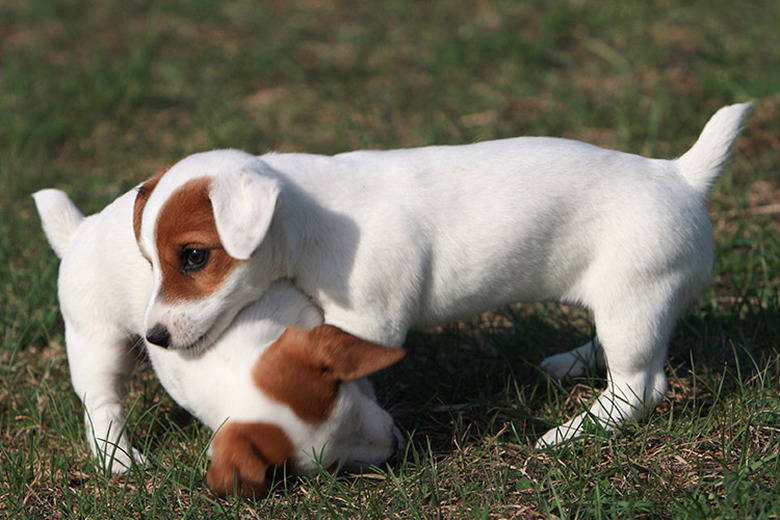Why Do Dogs Wrestle With Each Other?
Dogs begin wrestling as puppies and learn how to do it both from mom and from each other.
Since dogs are domesticated creatures, they seek playtime throughout their entire lives. For some dogs, wrestling is a favorite game. Dogs can also use wrestling to communicate with each other, as well as to burn off extra energy.
Wrestling as a Learning Tool for Puppies
Most of the play puppies engage in is a form of practice for adult dog behavior. They're learning from each other and their mothers what is and isn't acceptable doggy behavior. Wrestling teaches puppies how to interact with each other without making one another uncomfortable. A puppy who wrestles too roughly, for instance by biting too hard, will be corrected by his sibling "victims" when they run off or bite back. The puppy who plays too roughly learns that his unacceptable behavior causes the game to end, and the puppy who runs off or bites is practicing self-defense.
Wrestling as Play in Adult Dogs
Lots of dogs still enjoy wrestling when they're grown up. Two dogs who are evenly matched and displaying "happy" body language are engaging in healthy, normal play and should be encouraged. Dogs who are having a good time wrestling continue to engage each other, rather than one dog trying to escape the other. They take turns being in control and they chase each other to continue the play. Their faces and bodies are relaxed, showing no tension. Their tails are up or wagging, rather than hanging low or tucked between their legs.
Wrestling for Conflict Resolution
Sometimes dogs wrestle because they're trying to sort out who should have priority over resources in a particular competitive situation–for example, who gets to play with a toy first. The dogs involved will show different body postures and facial expressions from dogs who are simply playing around. Their faces may show tension, and their eyes may be fixed on one another intently. A dog who's trying to gain the upper hand at that moment will pin his opponent to the ground and won't let him up to continue tussling. They might try to mount each other. If a dog allows himself to be mounted, he has submitted. Some dogs will eventually work out who "wins" this particular conflict without resorting to real aggression. However, you should always keep a close watch. If the dogs bare their teeth in addition to looking tense, with their tails straight out or hanging, this is a bad sign and they should be separated before the aggression escalates.
By Madeline Masters
References
The Dog Trainer: How Can You Tell When Dogs Are Playing or Fighting?
PetPlace: How Dogs Play
Diamonds in the Ruff: Reading Dog Body Language
The Dog Trainer: Ganging Up at the Dog Park
Free Dog Training Info: Dog Mounting, Humping, Offensive Sniffing
Modern Dog: How to Read Your Dog's Body Language
About the Author
Madeline Masters works as a dog walker and professional writer. In the past she has worked as a fitness columnist, fundraising copywriter and news reporter. Masters won two Pennsylvania Newspaper Association Awards in 2009. She graduated from Elizabethtown College with a Bachelor of Arts in English.
